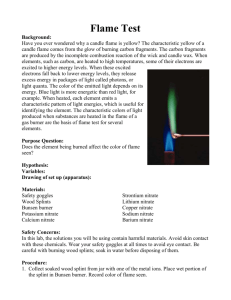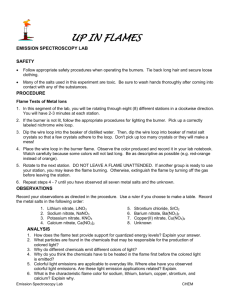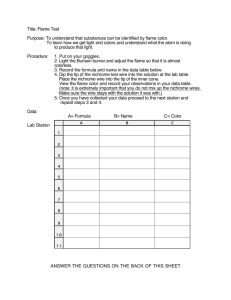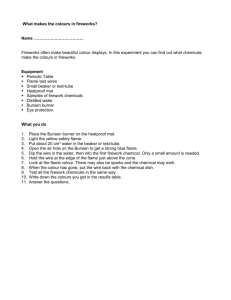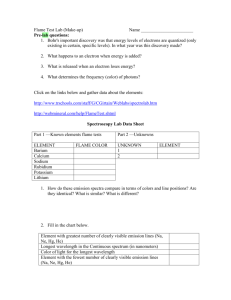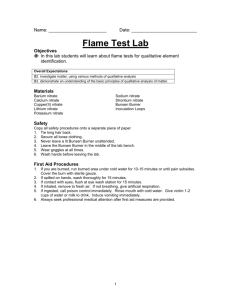Investigation - Centennial Christian School
advertisement
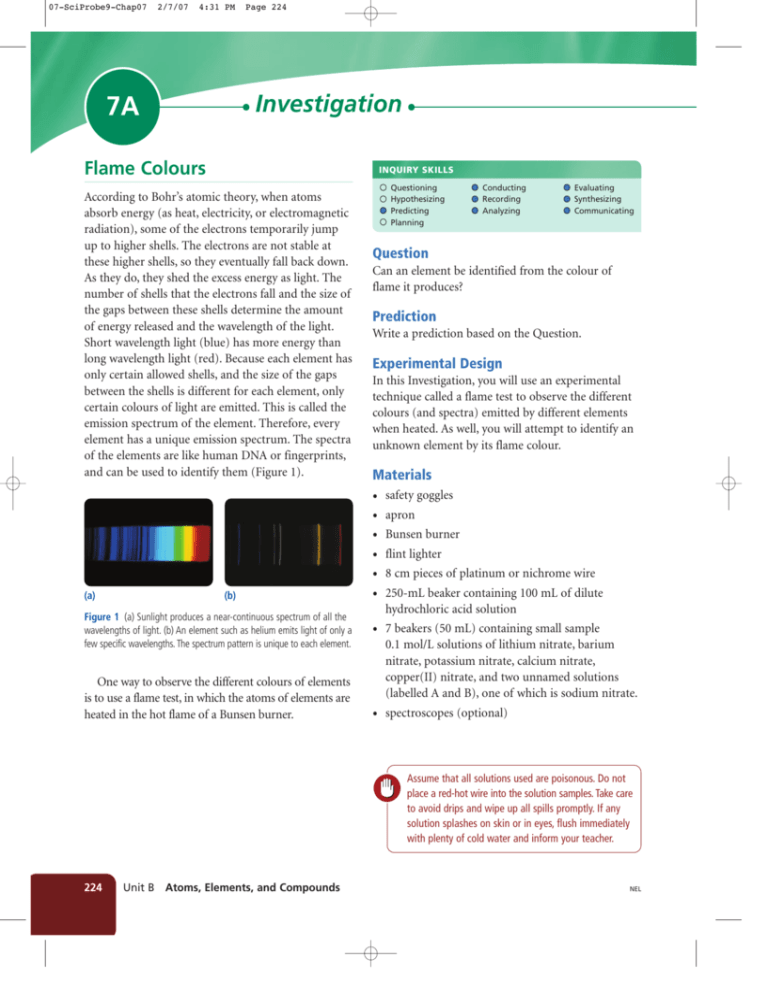
07-SciProbe9-Chap07 2/7/07 4:31 PM Page 224 Investigation 7A Flame Colours INQUIRY SKILLS According to Bohr’s atomic theory, when atoms absorb energy (as heat, electricity, or electromagnetic radiation), some of the electrons temporarily jump up to higher shells. The electrons are not stable at these higher shells, so they eventually fall back down. As they do, they shed the excess energy as light. The number of shells that the electrons fall and the size of the gaps between these shells determine the amount of energy released and the wavelength of the light. Short wavelength light (blue) has more energy than long wavelength light (red). Because each element has only certain allowed shells, and the size of the gaps between the shells is different for each element, only certain colours of light are emitted. This is called the emission spectrum of the element. Therefore, every element has a unique emission spectrum. The spectra of the elements are like human DNA or fingerprints, and can be used to identify them (Figure 1). (a) (b) Figure 1 (a) Sunlight produces a near-continuous spectrum of all the wavelengths of light. (b) An element such as helium emits light of only a few specific wavelengths. The spectrum pattern is unique to each element. One way to observe the different colours of elements is to use a flame test, in which the atoms of elements are heated in the hot flame of a Bunsen burner. Questioning Hypothesizing Predicting Planning Conducting Recording Analyzing Evaluating Synthesizing Communicating Question Can an element be identified from the colour of flame it produces? Prediction Write a prediction based on the Question. Experimental Design In this Investigation, you will use an experimental technique called a flame test to observe the different colours (and spectra) emitted by different elements when heated. As well, you will attempt to identify an unknown element by its flame colour. Materials • • • • • • safety goggles • 7 beakers (50 mL) containing small sample 0.1 mol/L solutions of lithium nitrate, barium nitrate, potassium nitrate, calcium nitrate, copper(II) nitrate, and two unnamed solutions (labelled A and B), one of which is sodium nitrate. • spectroscopes (optional) apron Bunsen burner flint lighter 8 cm pieces of platinum or nichrome wire 250-mL beaker containing 100 mL of dilute hydrochloric acid solution Assume that all solutions used are poisonous. Do not place a red-hot wire into the solution samples. Take care to avoid drips and wipe up all spills promptly. If any solution splashes on skin or in eyes, flush immediately with plenty of cold water and inform your teacher. 224 Unit B Atoms, Elements, and Compounds NEL 07-SciProbe9-Chap07 2/7/07 4:31 PM Page 225 Procedure 1. Work with a partner. Read through the procedure and make a table to record your observations. 10. Refer to the spectrum of sodium shown below in Figure 3. Repeat steps 5 to 8 for the two unnamed solutions labelled A and B. 2. Review the safety rules for working with a Bunsen burner. Put on your safety goggles and apron. 3. Ignite the Bunsen burner. Your teacher will show you how to adjust it to produce the hottest flame possible. 4. Bend a small loop at the end of the wire, about the size of a pencil lead (2 mm to 3 mm in diameter). 5. Holding the wire at the opposite end, dip the loop in the dilute acid solution to clean it. Remove the excess acid by touching the loop to the inside of the beaker. Figure 3 The spectrum of sodium 6. Dip the loop in the lithium nitrate solution. Do not remove the excess. Analysis 7. Slowly place the loop into the hottest part of the flame (Figure 2). The tip of the inner cone is the hottest part of a flame. (a) Did each solution have a unique flame colour? If not, which solutions had the same (or similar) flame colours? hottest part of flame wire loop holding solution to be tested (b) Which of the two unnamed solutions, A or B, was sodium nitrate? Explain. (c) Why were nitrate compounds used for all the solutions? Evaluation (d) Were you able to identify which unnamed solution, A or B, was sodium nitrate? How could the test be improved to make the identification easier? Synthesis Figure 2 Step 7 8. Record your observations about the colour of the flame. If you have spectroscopes available, try to observe the spectra of the flames while your partner inserts the loop in the flame. (e) Explain how you might determine if an unknown white solid was sodium chloride (table salt). Note that a taste test is never recommended! 9. Repeat steps 5 to 8 for each of the other four named solutions. NEL Chapter 7 Investigation 225


